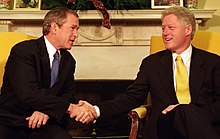 Outgoing President Bill Clinton (right) and President-elect George W. Bush (left) meet in the Oval Office of the White House as part of the presidential transition on December 19, 2000 | |
| Date of election | November 7, 2000 |
|---|---|
| Transition start | December 12, 2000 |
| Inauguration date | January 20, 2001 |
| President-elect | George W. Bush (Republican) |
| Vice president-elect | Dick Cheney (Republican) |
| Outgoing president | Bill Clinton (Democrat) |
| Outgoing vice president | Al Gore (Democrat) |
| Headquarters | McLean, Virginia |
Chairman of the transition | Dick Cheney |
| ||
|---|---|---|
| Transitions | ||
Planned transitions
|
||
| Related | ||
| ||
|---|---|---|
|
Business and personal
46th Governor of Texas 43rd President of the United States
Tenure Presidential campaigns  |
||
The presidential transition of George W. Bush took place following the 2000 United States presidential election. It started after Bush was declared the victor of the election on December 12, 2000, when the Bush v. Gore decision by the Supreme Court halted the election recount in Florida, making Bush the victor in that state. The decision delivered him the state's 25 electoral votes, thus giving him a total of 271 electoral votes. This was one more vote than the 270 needed to win the presidency outright, making him president-elect.
Due to the recount effort and litigation between Bush and his presidential opponent Al Gore leaving the outcome of the election unclear until December 12, 2000, Bush's official transition was abbreviated, at just 39 days. The transition was chaired by vice president-elect Dick Cheney.
Bush's victory was formally certified on January 6, 2001, when a joint session of congress certified the electoral college count.[1][2] The transition ended when Bush was inaugurated on January 20, 2001. This was the first presidential transition to be held after the passage of the Presidential Transition Act of 2000.[3]
- ^ Mitchell, Alison (7 January 2001). "Over Some Objections, Congress Certifies Electoral Vote (Published 2001)". The New York Times. Retrieved 30 January 2021.
- ^ Glass, Andrew (6 January 2008). "Congress certifies Bush as winner on Jan. 6, 2001". POLITICO. Retrieved 6 February 2021.
- ^ Smith, Stephanie (11 February 2008). "CRS Report for Congress Presidential Transitions" (PDF). Congressional Research Service. Retrieved 29 January 2021.


